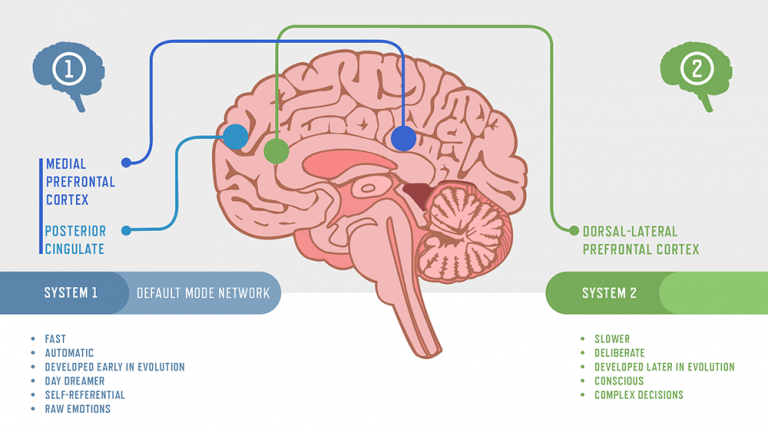Our Two Brains, Mindfulness, and Decision-Making

By Mark Mitchnick, guest contributor
Long before any of the neuroscience was known, Winston Churchill said, “Fear is a reaction. Courage is a decision.” Although he didn’t know it, Mr. Churchill was actually describing the two separate yet conjoined systems operating in our heads.
Over the past 15 years, what these two systems look like and how they function has been described in both scientific and general publications. Together, they inform the understanding of our decision-making process and how mindfulness works.
Two of the more popular descriptions of the components of these systems and how they work are the Default Mode Network (DMN) and Nobel prize recipient Daniel Kahneman’s System 1/System 2 as described in his widely acclaimed book, Thinking, Fast and Slow (See the illustration).
On a macro level, the DMN and Kahneman’s System 1 share the same functionality and, although not as widely appreciated, are also consistent, along with Kahneman’s System 2, with work described by addiction psychiatrist and neuroscientist Judson Brewer. The DMN was discovered while researchers were looking to measure baseline brain activity and, instead of finding an electrically “quiet” brain, they saw that people at “rest” had lots of consistent brain activity, especially in two areas known as the medial prefrontal cortex (mPFC) and the posterior cingulate cortex (PCC) (Figure 1).
In short, this early work and subsequent investigations showed that at rest, we are actually thinking a lot, essentially daydreaming, and these brain regions are active. One of the common components of our “thoughts” in this state is that they are self-referential. In other words, we are thinking about ourselves in some way–for example, fantasizing about what we will do in the future or what so-and-so did to us in the past. In fact, it turns out that we spend about 50% of our waking hours in this state.
Separately, Kahneman famously described System 1 and System 2, the fast and slow systems respectively. System 1 is an evolutionarily old and primitive emotional system. It resides in areas including the mPFC and the PCC, which, not coincidently, is the same as the DMN. System 1 bypasses rational thought and is largely subconscious and very fast. Its speed is both its greatest attribute and downside.
For example, when one is physically threatened, System 1 is the go-to network, invoking the commonly referred to fight-or-flight response. As we have evolved, however, life situations have become more nuanced and such binary decisions are not as useful--but our basic neuroanatomy hasn’t yet entirely caught up to this.
Instead we continue to, by default, operate in System 1 most of the time. In fact, the more stressed we are, the more this is the case. While this may still convey some survival advantage, it is certainly not optimized for modern living. For example, despite what your old brain is whispering to you when you are having a disagreement with your spouse or co-worker, the fight or flight responses are clearly not the two most functional options. On their own, those options will likely not lead to a great outcome.
Kahneman’s System 2 on the other hand, involves the evolutionarily more recent dorsolateral PFC (dlPFC). System 2 is slower and credited with more thoughtful and conscious decisions. This is consistent with the notion that early brain regions were built to be reactive and fast as that is what was needed at the time. Later brain regions evolved because our needs changed as we changed or, alternatively, our needs changed as our brain evolved. Either way, the ability for us to reason and override instinct arrived only relatively recently.
So, how do these brain systems actually relate to mindfulness and decision-making? It turns out that mindfulness practice impacts the same brain regions described above. This of course makes sense.
One key part of the definition of mindfulness is being present or aware of the current moment, the opposite of being caught up in daydreaming. Think DMN.
The other definitional component is being non-judgmental. This one requires some explanation. When judging something, for example, as good or bad, the judgment is relative to us personally. “I don’t like blue couches.” “That person’s voice really bugs me.” “I love scrambled eggs.” All of these “judgments” are self-referential. Remember, the self-referential role of the PCC in the DMN.
In mindfulness training, one learns to be present (not daydreaming) in whatever is happening at that moment and, importantly, in a non-judgmental way. In other words, one learns to allow themselves to be well connected to, and actually part of, objective reality.
Mindfulness then describes a state of mind where System 2 is available, the DMN (System 1) is not dominating and self-referential thinking is minimized. In other words, one is fully engaged, aware of others, not thinking excessively about themselves and accepting reality as it is at that moment.
It’s a state where one can decide, as Mr. Churchill suggests, to be courageous.
Mark Mitchnick, MD, is the Chief Executive Officer of MindSciences (https://www.mindsciences.com) and a seasoned life sciences executive with extensive global health experience.

0 comments
Leave a comment